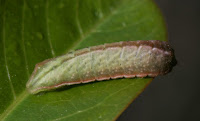On a warm evening in February a
group of Field Nats gathered at Judi and Brendon Gray’s property in anticip-ation
for the light to fade and what creatures this may unveil. The Grays are true
environmentalists, they live and breathe being custodians of the land. They
also have shown great respect to the local traditional custodians through naming
their property after them, Jarowair. (For more information check out the Gray’s
blog http://jarowairourpatch.blogspot.com.au/)
As the sun was setting and we
waited for everyone to arrive we got our torches ready (thanks to Trish
bringing red cellophane) so we didn’t hurt any eyes. Then off we headed into
the dark. The first encounter was a beauty-ful Tawny Frogmouth (Podargus strigoides) that the Grays had
cared for in the past, now often returning for a snack and visit. As we
wandered further into the property we discovered a number of Geckos, including
the Robust Velvet Gecko (Oedura robusta),
Bynoe’s Gecko (Heteronotia binoei), Stone Gecko (Diplodactylus vittatus) and a very cute Barking Gecko (Underwoodisaurus milii) which fell in love with Trish G’s
pants. Judi pointed out that due to the tail being darker we could confirm that
this Gecko still had its original tail.
As we wandered around we meet
various Orb spiders, came across a Rocket Frog (Litoria nasuta) in the dry creek bed, saw an Ornate Burrowing Frog
(Opisthodon ornatus) and Bleating
Tree Frog (Litoria
dentata). To the
delight of many we also saw two Koalas in the neighbouring property, one small
one was sitting in an Iron bark, not a Koala food plant but a favourite for
resting. The occasional Brush tail possum was seen and we were impressed at the
number of nesting boxes the Grays had put up around the property. As we
finished the circuit walk and after a drink of lovely cool water, we were drawn
like moths to Helen Schwencke’s insect light trap.
What an amazing array of invertebrates
were found on the lit-up sheet! The king of them all was a beautiful large
eucalyptus moth. Others included a robber fly, variety of leaf beetles, lacewings,
katydids, horse headed katydid, emerald moths, and many other. Glenda made
friends with a quite large click beetle that later in the night showed us his
beautiful antennae. Helen is an amazing source of information and shared an
insight, “If you want to plant for
wildlife then the best place to start (and the most essential) is to plant for
the invertebrate”. This is something I will be taking into my gardening!
What a fantastic night! Thanks to the Grays, Helen and everyone who came.
(Report by Jane Orme. Photographs below by Jim Ball)
 |
| Thick-tailed Gecko - Nephrurus milii |
 |
Broad-palmed
Rocket Frog - Litoria latopalmata
|
 |
| Ornate Burrowing Frog - Platyplectrum ornatum |
 |
| Northern Emerald Moth - Prasinocyma rhodocosma (identified by Don Gardner) |
 |
| Rhinoceros Beetle - Xylotrupes gideon |







